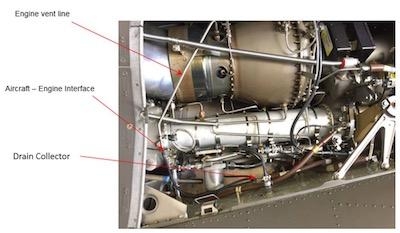Mon, Nov 27, 2017
January Accident May Be Related To Problem With Engine Oil Drain System
The FAA has issued a Special Airworthiness Information Bulletin (SAIB) warning of a possible blockage of the engine oil drainage system on Airbus Helicopters Deutschland (Airbus Helicopters) Model MBB-BK 117 C-2 helicopters.

On January 26, 2017 an operator of a BK117 C-2 experienced an in-flight engine fire and made an emergency landing in Sioux Falls, South Dakota. Although still under investigation, the engine fire could be related to engine oil coke chips plugging the return scavenge line for the rear bearing of the gas generator. On September 8, 2017 a BK117 C-2 helicopter was destroyed when it crashed near Hertford, North Carolina. The NTSB preliminary investigation found that the number 2 engine rear turbine shaft bearing exhibited discoloration consistent with overheating and lack of lubrication. Through the course of inspecting the engine issue for scavenge line blockage, a BK117 C-2 operator discovered a separate, airframe-related issue. The operator detected various levels of coking blockage of engine drain lines. Airbus Helicopters prescribes a general visual inspection of the bearing compartment area. There are no prescribed inspections of the drain tube or drain collector to check for blockage. A blocked
drain line may, under certain circumstances, present a risk for an engine fire and/or inflight shutdown of the affected engine.
The FAA recommends the actions below for all owners, operators, and maintainers of Airbus Helicopters BK117 C-2 helicopters. The actions should be performed for each engine at intervals not to exceed 100 hours time-in-service (TIS). Refer to Fig. 01 in Airbus Helicopters AMM 71-71-01, dated March 1, 2016 and to Figure 1 of this SAIB.
Disconnect the rear bearing lines part numbers AE709636-1 (hose), 117-600381.111 (hose), and 117-600381.105 (hose) from the drain collector part number B717M1028801 or 117-602061 (drain collector) and disconnect the drain collector from the engine deck.
Visually check the drain collector and hoses for obstructions. These obstructions may include carbon and coke deposits. Contact Airbus Helicopters for recommended cleaning procedures if there are any obstructions.
If there are no obstructions or after performing the above actions, reconnect the drain collector to the engine deck and reconnect the drain/vent lines to the drain collector per approved maintenance instructions.
(Image provided with FAA SAIB)
More News
Also: New Lakeland Fly-in!, Gleim's DPE, MOSAIC! Nearly three-quarters of a century in the making, EAA is excited about the future… especially with the potential of a MOSAIC>[...]
Estimated (EST) -When used in NOTAMs “EST” is a contraction that is used by the issuing authority only when the condition is expected to return to service prior to the >[...]
Aero Linx: Regional Airline Association (RAA) Regional airlines provide critical links connecting communities throughout North America to the national and international air transpo>[...]
The Airplane Broke Up In Flight And Descended To The Ground. The Debris Path Extended For About 1,435 Ft. Analysis: The pilot, who was the owner and builder of the experimental, am>[...]
From 2015 (YouTube version): History Comes Alive Thanks to A Magnificent CAF Effort The story of the Douglas C-47 named, “That’s all Brother,” is fascinating from>[...]
 Airborne 07.21.25: Nighthawk!, Hartzell Expands, Deltahawk 350HP!
Airborne 07.21.25: Nighthawk!, Hartzell Expands, Deltahawk 350HP! ANN's Daily Aero-Term (07.27.25): Estimated (EST)
ANN's Daily Aero-Term (07.27.25): Estimated (EST) ANN's Daily Aero-Linx (07.27.25)
ANN's Daily Aero-Linx (07.27.25) NTSB Final Report: Luce Buttercup
NTSB Final Report: Luce Buttercup Classic Aero-TV: 'That's All Brother'-Restoring a True Piece of Military History
Classic Aero-TV: 'That's All Brother'-Restoring a True Piece of Military History



